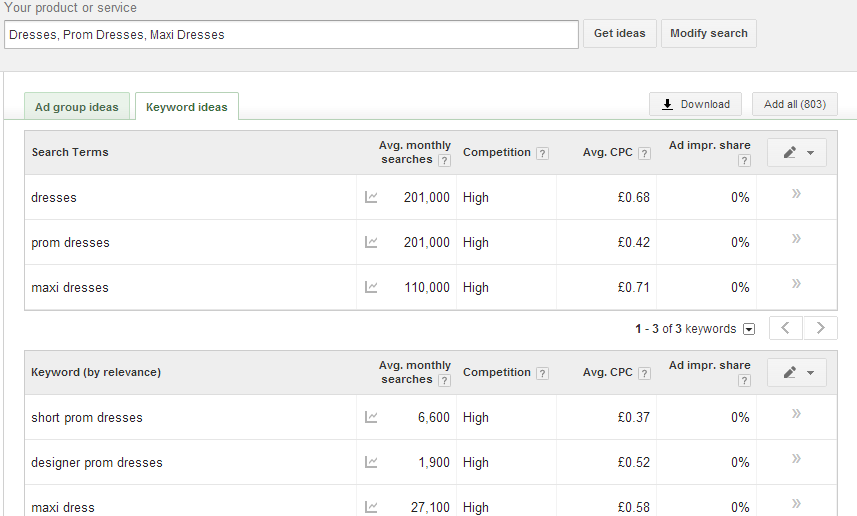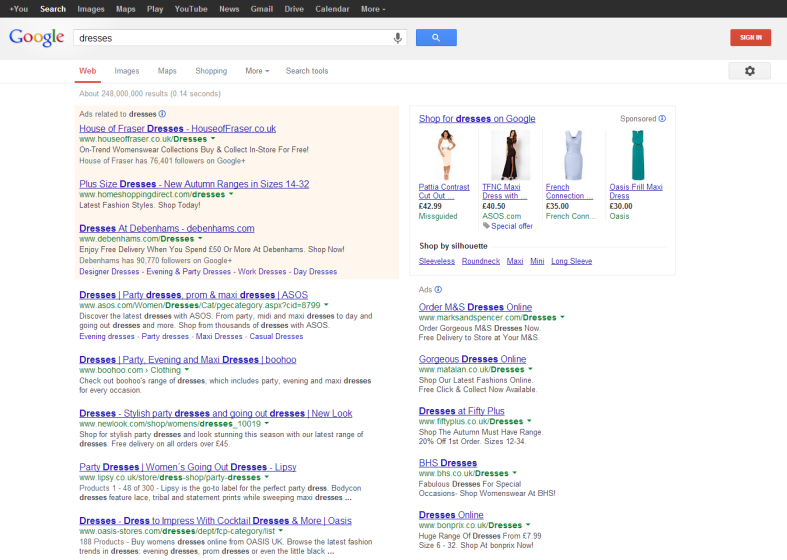Working with many fashion clients we are constantly asked to optimise their content and websites for popular, high volume search terms such as “dresses”, “prom dresses” and “maxi dresses”. These terms all have high search traffic and represent massive sales potential for the websites that can get high up the SERPs.
Lets quickly do the maths on this: we need to look at search term volumes, click-through rates (CTR), website conversion rates and then the average order value on the site. (All the numbers used in this blog post are fictional for the purpose of illustrating a point rather than the actual clients numbers)
Search Volumes
Lets look at “dresses” on the SERP – this search was carried out on a Chrome incognito browser from a hotel in Hampshire while not signed into Google!
As we can see from the SERP ASOS is position one. Based on common industry stats they could expect to get 25% of the search traffic so that should be 201,000 x 25% = 50,205 visitors to the website. Lets assume a conversion rate of 2%, so 50,205 x 2% = 1,005 dresses sold. If there is an average order value of £60 then the revenue from this per month is £60,300. Interestingly, if you wanted to get 50,250 clicks from PPC it would cost £34,170.
Now lets look at Boohoo, New Look and Lipsy, which all have dresses on sale for under £20 and are probably targeting a different audience to say House of Fraser and Marks and Spencer, with the latter retailers generally boasting a higher average basket price. House of Fraser for example has several dresses on sale for over £500.
So what, I hear you say, retailers selling dresses for different prices is pretty obvious. But I think that Google could do better for the consumer. Lets make a few assumptions and choose a few characters in my life to help us make this point:
- (From left to right) My Mum – Val Readman aged over 50, retired and could be described demographically as a SKI – “Spending kids inheritance”
- My Wife – Nikki Readman, mid 30s, works in marketing and is a mother of two beautiful girls (I’m a bit biased)
- My Cousin Georgina – Just graduated from Uni and about to start her first job in London
So we have now introduced a few characters who all shop online regularly for dresses. However, before I analyse who they search on Google and if Google does a good job for them I just wanted to explore what the search engine actually knows about us. This is fascinating and I recommend you check it out: carry out a Google search for “Google ad preferences” like below. For this to work you do need to be logged into Google.
What you then see is who Google thinks you are. Some of it is obvious because it is data that is actually provided to Google+. What is more interesting is what assumptions Google is making about me based on my online behaviour.
If you click the edit link you can see all the things Google thinks you are interested in (right). You can control these and edit them if you want.
Most of mine are accurate – not too sure about “Cats” though.
Currently Google uses some demographic options in paid advertising specifically on retargeting. The questions I want to pose is, if they know all this information why don’t they make the SERP for “dresses” a better, more relevant experience for the end user?
After a quick survey with the members of my family who all buy dresses online the following becomes very clear:
- My Mum when searching would only consider shopping at House of Fraser and Marks and Spencer based on the SERP for “Dresses”.
- Nikki however would shop at the majority of them, but probably not Boohoo or Lipsy. Her preferred choice was ASOS and she would click them even if they weren’t number one.
- Georgina said that Boohoo and New Look were the ones she would most likely to click and that House of Fraser, Oasis and Warehouse were probably a bit too expensive.
So based on this quick survey of three (not that statistically significant!) the Google SERP is only really relevant for one person out of three – Nikki.
This seems very obvious that for such a generic term like “dresses” everyone wants different results. If Google has the data then shouldnt it use it? Or why not make it even easier for the website owners and let them tag their site with a demographic tag – maybe Rel = demog or gender for specific pages. There are many other examples of this, take searches for “shoes”, “suits” or “jeans” – how does Google know when to present men’s or women’s pages?
Until Google develops and rolls out what Im going to call the 2D SERP, most brands and ecommerce sites have to focus on the longer tail to ensure they attract the more relevant, higher converting traffic.
This small survey also opens up the whole conversation about conversion attribution. As when I asked my family, the general consensus was that when shopping online they would browse lots of different sites, clicking on PPC and product listing image adverts in the process, before making a purchase.
This is a topic for a different blog, but in the meantime we are hosting a conversion attribution event on October 2 in London with our partners DC Storm. Places are limited, but if you would like to attend and learn more about where your online sales are coming from, please sign up here.







